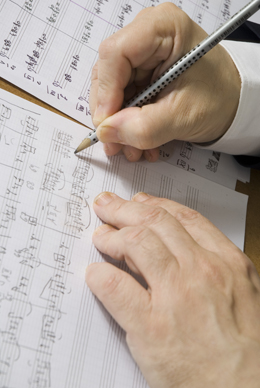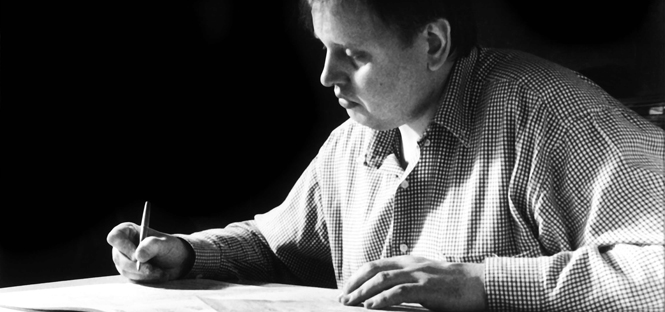My compositional work is rooted in the continuously renewing line leading from Bach through Schoenberg to the present: the great composers of this tradition have left their traces in my work.
My compositions up to about 1981, including op. 6, as well as the Miniatures for 2 violins and pieces for several violins from the first book of the Violin Method op. 26 and their later arrangements such as the Balkan Mosaic op. 26 l bis, could be designated as »early works« (although the later harmonic alterations demand the experience of a veteran composer). They are characterized by freely tonal and quasi-improvisational elements, and rely occasionally on quotations from older music.
From 1980 onwards I have been increasingly occupied with processes of structural transformation in the broadest sense, and these have led me through theory as well as through listening to an individual form of harmony and subsequently to an original forming of gesture. At first I directed my attention upon the different qualities of intervals within diverse chord sequences. Two phases can be distinguished here: the first is marked by a proximity to the ideas of the Second Viennese School, whereby however not so much the dodecaphonic technique itself as rather the harmonic successions produced by the row formations stands in the foreground. My preference for five-part chords, which would later become even stronger, must have originated here! Opus numbers 7 to 9, both the first two Divertissements Suisses op. 10 as well as several movements of the third and fourth (op. 10 / 1—4), the Premier Trio pour piano, violon et violoncello, en un mouvement op. 11 / 1, the Pieces for a cappella choir from op. 12, the first part of Fragments of a Dream Play op. 13, the Sorgemusik för Olof Palme op. 13a, as well as the Ständchen und Sitzchen for Ernst Krenek's 85th birthday op. 14/1a-b, were all written during this phase.

From around 1985 onwards, the late encounter with the avant-garde of the 1950’s, whose most prominent exponents might be Stockhausen, Nono, Boulez, Xenakis, Haubenstock-Ramati, and Ligeti, led progressively to a new orientation. Even though these composers were known to me, I had up till then not occupied myself creatively with their music, either as interpreter or as composer.
One can already sense this new impulse in the Halbthurn Capriccioso per Roberto op. 14/2, in the work … Da stehn wir mit Spiegeln ... und fangen auf I and II (from op. 15), the Visions op. 17, in the composition ... Ich bin es, ohne dass es mir gleicht ... for soprano, baritone, and chamber ensemble op. 19 (withdrawn for revision), the Four Songs op. 20 and in the Colliding movements op. 21/1. But only the following works were to fully incorporate the new insights and then go beyond them.
The Hommage à Ligeti op. 14/3a, written between 1989 and 1996, are the record of an approach to and then distancing from his work. The Gemini duos op. 24 are an experimental field for the relation of two chords to one another.
These two phases of development have provided the impulse for the work I have done since the 1990’s. My works were from then on to be marked by chord dispositions (i. e. the relayering of intervals within a chord) and by rhythmic formations involving the relation of different tempos.
A further individual characteristic is that I like to assemble single works into cycles, even if these works are written for different formations. In op. 22, for example, such important works as Metamorphoses of a Labyrinth op. 22a, La Fontaine de Sang, Vanished Dreams. Six Sketches for String Quartet op. 22c, Metropolitan Midnight Music op. 22d, Clichés, Descendances imaginaires, the oratorio Hammabbul, Inventions, The Day after the Rain, and the 5x5 Short Intermezzos op. 22j have been grouped together as op. 22a through 22j. Other cycles are still in progress, such as the Homages op. 14.
In the recently created works the harmonic relations become richer and more complex, ordering themselves interactively upon points of reference equally based on inversions, transpositions, and dispositions. This is for example the case with the Minotaur Study op. 23a, the second book of miniatures in the Violin Method op. 26 II, the Studies for Strings op. 27, the Studies for Winds op. 29, and Europe Fanfares op. 28, PreFan op. 28 bis, the Adagio in Memory of Nino Bello (from Quintets op. 32), Monumentum pro Thomas Alva Edison op. 34, and Cat Music op. 38. An individual theory of harmony is developed within the above-mentioned work cycle op. 22.
 The idea of a new harmonic structuring of popular music with the help of the harmonic means available to us today led to the project POP revolution, which has evidenced its potential not just in one work, but through an idea which is continuously further developed in new pieces. This explains the considerable number of works bordering on »light music«, the numerous arrangements, and also the works with parodistic elements, for example April op. 3 or A Mirage turned upside down.
The idea of a new harmonic structuring of popular music with the help of the harmonic means available to us today led to the project POP revolution, which has evidenced its potential not just in one work, but through an idea which is continuously further developed in new pieces. This explains the considerable number of works bordering on »light music«, the numerous arrangements, and also the works with parodistic elements, for example April op. 3 or A Mirage turned upside down.
Finally I am also interested in the purely harmonic sense in the possibilities of microtonality, whereby I am aware of the problem of being fully capable of grasping this form of interval construction by ear. Differentiated suggestions for solutions can be deduced from Descendances imaginaires op. 22f, the Inventions op. 22h, and the violin 30 Miniatures for 2 violins (1974-76) and 8 Pieces for several violins from the first book of the Violin Method op. 26 I.
The compositions Rinne Ten-Sho op. 30 for traditional Japanese instruments and violin (from op. 30) as well as Moyo op. 31 also belong in a certain sense to this complex of ideas. (René Staar, January 2012)



